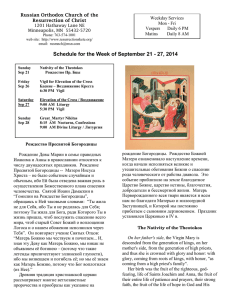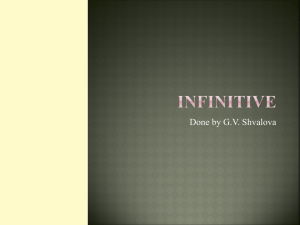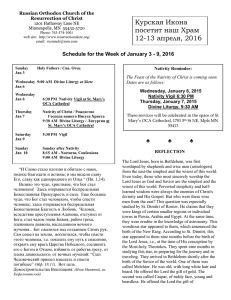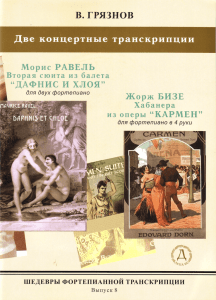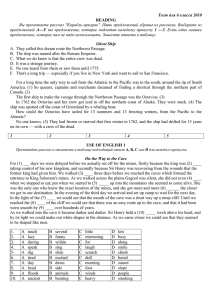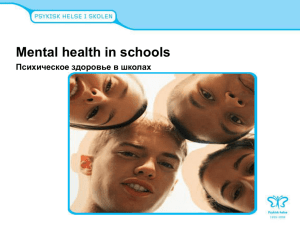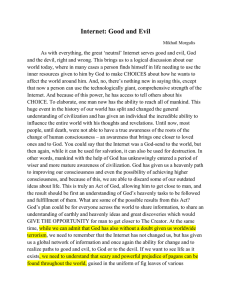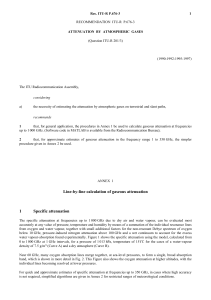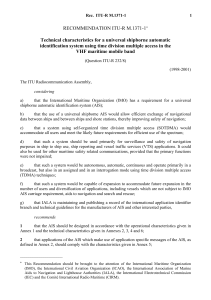1 - ФГУП НИИР
реклама
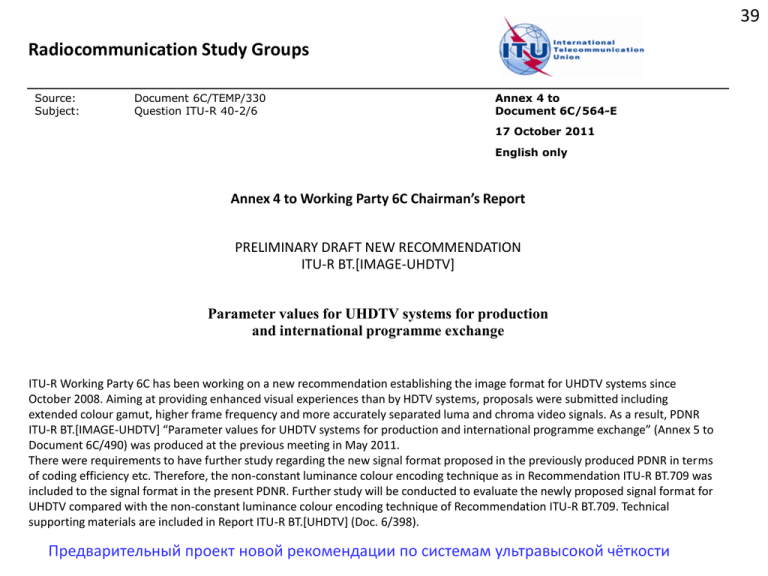
39 Radiocommunication Study Groups Source: Subject: Document 6C/TEMP/330 Question ITU-R 40-2/6 Annex 4 to Document 6C/564-E 17 October 2011 English only Annex 4 to Working Party 6C Chairman’s Report PRELIMINARY DRAFT NEW RECOMMENDATION ITU-R BT.[IMAGE-UHDTV] Parameter values for UHDTV systems for production and international programme exchange ITU-R Working Party 6C has been working on a new recommendation establishing the image format for UHDTV systems since October 2008. Aiming at providing enhanced visual experiences than by HDTV systems, proposals were submitted including extended colour gamut, higher frame frequency and more accurately separated luma and chroma video signals. As a result, PDNR ITU-R BT.[IMAGE-UHDTV] “Parameter values for UHDTV systems for production and international programme exchange” (Annex 5 to Document 6C/490) was produced at the previous meeting in May 2011. There were requirements to have further study regarding the new signal format proposed in the previously produced PDNR in terms of coding efficiency etc. Therefore, the non-constant luminance colour encoding technique as in Recommendation ITU-R BT.709 was included to the signal format in the present PDNR. Further study will be conducted to evaluate the newly proposed signal format for UHDTV compared with the non-constant luminance colour encoding technique of Recommendation ITU-R BT.709. Technical supporting materials are included in Report ITU-R BT.[UHDTV] (Doc. 6/398). Предварительный проект новой рекомендации по системам ультравысокой чёткости 39а В 1993 г. Ассамблея Радиосвязи одобрила предложения председателя 11 ИК МСЭ-Р. (Отчет председателя 11 ИК. Док.11/1001, 30 сентября 1993 г.) по гармонизации цифровых систем доставки ТВ-служб потребителю и технологий ТВ-вещания с перспективными компьютерами. Вскоре был разработан новый Вопрос МСЭ-Р 95/6 и отчет, а затем и первый проект рекомендации по использованию компьютерных технологий и Интернет в ТВ-вещании (МСЭ-Р, Отчет председателя 11 ИК. Док.11/13, 5 марта 1998 г.). Предусматривалось дополнение телевизоров рядом интеллектуальных возможностей. Международные усилия привели к достижению заветной планки - выпуску современных телевизоров, работающих с Интернет, и обеспечивающих другие инфокоммуникационные услуги. Принята Рекомендация ВТ.1888 (09/2011) Базовые элементы систем файлового вещания (требования к системе, транспортировка файлов, приёмники и др.). Благодаря всевозрастающей многопрограммности и Интернет стало доступно изобилие видеоинформации. В результате снижается вероятность просмотра в определённое время важного государственного, общественного и другого заданного контента. Этот фактор необходимо учитывать. ТВ-вещание и телевизоры с инфокоммуникационными услугами 40 Видеоинформационные системы (ВИС) – это многофункциональные интерактивные системы, впервые обеспечивающие высококачественное наружное ТВ-вещание, воспроизведение 2D/3D видеоинформации на экранах различных размеров в многолюдных местах как на открытом пространстве (площади, улицы, стадионы и т.п.), так и в закрытых помещениях (залы, торговые центры, метро и т.п.). Места установки экранов и контент ВИС должны регламентироваться. Широкое внедрение ВИС станет самым эффективным средством просмотра заданного ТВ-контента, впервые обеспечит массовую экранизацию общества. 41 Укрупнённая модель функционирования интерактивных видеоинформационных систем Программные функции Технические функции Оптимальная интеграция ТВ и мультимедийного вещания и собственных программ ВИС Формирование и передача сигналов ВИС, отображение, интерактивность Участники Участники Телерадиовещательные и кино компании, создатели контента, рекламы, компьютерные службы и др. Операторы цифровых каналов наземного и спутникового вещания, кабельных, ВОЛС, электросетей подвижной связи, систем отображения и др. Управление Центры управления распределением федеральных, региональных, местных и передаваемых за рубеж программ ВИС, оповещение, безопасность, интерактивность, указание местонахождения абонента, загрузка, расчёты и др. 42 INTERNATIONAL TELECOMMUNICATION RADIOCOMMUNICATION ASSEMBLY Document 6/1001-E 8 April 2003 GENEVA, 2-6 JUNE 2003, 3 Chairman, Study Group 6 CHAIRMAN’S REPORT BROADCASTING SERVICES 7 Results of the extraordinary meetings of Study Group 6 …….. At its meeting in October 2001, Study Group 6 took the Decision (Document 6/184) that Task Group 6/9 on digital cinema broadcasting be established, subject to the approval of draft new Question ITU-R 15/6 “Digital cinema (D-cinema) broadcasting”. Question ITU-R 15/6 was subsequently approved by correspondence by ITU-R Member States. Task Group 6/9 is chaired by Mr J. Flaherty (USA). At the first meeting of the Steering Committee of Study Group 6 in September 2002, the Administration of the United States of America referred to the document “Review of the scope of Task Group 6/9” (Document 6/301) and proposed that Question ITU-R 15/6 should be reviewed by “a wider group of potentially affected parties with a goal of narrowing the scope of the work of TG 6/9 to radiocommunication related matters appropriate for consideration by the ITU-R”. The Steering Committee of Study Group 6 established an ad hoc Group chaired by Mr V. Stepanian (Iran) to consider the Terms of Reference of TG 6/9. It was decided that if the scope of the TG 6/9 were to change, then Question ITU-R 15/6 would need to be reviewed. Following the conclusion of the work of the ad hoc Group, the Steering Committee of Study Group 6 established a Drafting Group chaired by Mr S. Lieng (Australia) on 11 September 2002 to review Question ITU-R 15/6, by taking into account the work of the ad hoc Group (Document 6/320). At the Study Group 6 meeting in September 2002, it considered the reports of the ad hoc Group and of the Drafting Group on Question ITU-R 15/6 set up by the Steering Committee. However, it was not possible to reach a unanimous consensus on the revision of Question ITU-R 15/6. As a consequence, the Chairman of Study Group 6 decided to convene an Extraordinary Meeting of Study Group 6 on 18 March 2003, dedicated to solving the issue. For the collaboration and harmonization of international studies on numerous large screen applications the Honorary Chairman of Study Group 6, Prof. M. Krivocheev (Russia), proposed to use a new term “large screen digital imagery” as the title of this revised Question. К началу изучения цифровых систем с большими экранами 43 Radiocommunication Study Groups Document 6X/7-E 7 April 2008 English only Received: 4 April 2008 Subject: Questions ITU-R 114/6 Russian Federation PROPOSAL ON DRAFT REVISION OF QUESTION ITU-R 13/6 Multimedia evolution and common content format Currently information in population centers is being represented by traditional, mostly static means, in particular posters, broadsheets, other kinds of advertisement, etc. Some large imagery systems installed in crowded places (squires, railway stations, stadiums, subways, streets, routes with extensive traffic, etc.) also represent various kinds of multimedia information for business, advertising, concerts, shows, sport, cultural and other mass activity. But in many cases they are not sufficiently effective and do not provide the high quality of the represented information. So the efficient mass information servicing of population requires new approaches. Progress of informational, communicational and nanotechnologies, methods of digital TV signals formation, processing, compression, transmission and representation gives the possibility to execute this social order with the help of the new multifunctional, video informational (demonstration) systems on the basis of digital HDTV and EHRI technologies (Recommendation ITU-R BT.709 “Parameter values for the HDTV standards for production and international programme exchange”, Recommendation ITU-R BT.1201 “Extremely high resolution imagery” and Recommendation ITU-R BT.1769 “Parameter values for an expanded hierarchy of LSDI image formats for production and international programme exchange”), which allow viewers to discern even the smallest nuances of the demonstrated pictures. Video informational systems as integrated parts of digital TV broadcasting production and post production centers will allow broadcasters to organize new business applications with the help of multimedia content transmission in the form of data streams, which, in particular could be parts of the broadcasted programs’ transport streams. A possibility will occur to provide advertising business and various mass informational servicing structures with new digital TV multimedia broadcasting service. Broadcasters may play an important role in this process as leaders in this perspective area. It will allow to increase substantially the role and importance of digital TV broadcasting in creation and development of the information society and will contribute to the radical broadening of the spectrum of services with good economical prospects. Numerous telecommunication services are also interested in the development of such systems as potential sources of additional traffic. Предложения Российской Федерации (вклад подготовлен ФГУП НИИР) по началу изучений и международной стандартизации видеоинформационных систем Radiocommunication Study Groups Source: Document 6B/TEMP/60 Subject: Digital multimedia video Iformational systems Radiocommunication Study Groups Annex 9 to Document 6B/106-E 27 May 2009 English only Source: Document 6B/TEMP/104 Subject: Digital multimedia video Iformational systems Annex 9 to Document 6B/163-E 8 December 2009 English only Annex 9 to Working Party 6B Chairman’s Report Annex 9 to Working Party 6B Chairman's Report Establishment OF A RAPPORTEUR GROUP on digital multimedia video informational systems Continuation of the RAPPORTEUR GROUP on digital multimedia video information systems WP 6B (SWG 6B-2) considered Document 6B/102 contributed by the Russian Federation. The document shows an urgent necessity to study all the aspects and user requirements for digital multimedia video informational systems. The study of the user requirements for digital multimedia video informational systems (VIS) on the basis of high definition television (HDTV), large screen digital imagery (LSDI) and extremely high resolution imagery (EHRI) is included in Question ITU-R 45-1/6 “Broadcasting of multimedia and data applications”. These requirements can include a variety of the video information, displayed on the screen for collective viewing of various kinds of the broadcasting multimedia and information for business, advertising, concerts, shows, sport, cultural mass activity, etc. with screens installed in multicrowded places (squares, railway stations, stadiums, streets, parks, airports trade and cultural centers, shops, drugstores, etc.) provided with the help of VIS integrated in digital TV broadcasting. It is important to also have comfortable viewing of the image on the screen of the VIS display, contribution, distribution and management of content signals and other VIS aspects. Also of high importance for VIS is Question ITU-R 126/6 “Recommended operating practices to tailor television programme material to broadcasting applications at various image quality levels and sizings”. For the consolidation of the international efforts in this area and to accelerate the standardization process, it is proposed to establish a Rapporteur Group on digital multimedia video informational systems as well as to appoint the chairman of the group. Chairman of the Rapporteur Group The Rapporteur Group is led by: Professor Krivocheev (Russian Federation) as an Acting Chairman E-mail: intcoop@minsvyaz.ru All interested participants are encouraged to join the e-mail reflector. WP 6B received an excellent report, Doc. 6B/133, from the acting Rapporteur Group Chairman Professor Krivocheev. This report has a lot of important information on digital multimedia video information systems (VIS) and proposals for revising three Questions, 45-2/6, 126/6 and 131/6. In order to continue the Rapporteur Group, WP 6B requested Professor Krivocheev to serve as the Chairman of the group and he kindly accepted the request. Terms of reference of the Rapporteur Group – Study of VIS integration in digital TV broadcasting, methods for maintaining comfortable viewing of the images on screens of displays, interactivity, technologies of contribution, distribution, and management for secured content delivery and other aspects of digital multimedia video information systems. – The analysis of existing digital multimedia video information systems and preparing a brief progress report of existing and prospective technologies and devices, which can be suitable for these systems. – Preparation of working materials for the development of ITU-R Recommendations on digital multimedia video information systems. Chairman of the Rapporteur Group The Rapporteur Group is led by: Professor Krivocheev (Russian Federation) E-mail: m_krivocheev@mail.ru All interested participants are encouraged to join the e-mail reflector. К созданию группы по цифровым видеоинформационным системам 44 45 ПАТЕНТ Видеоинформационная система с интерактивным управлением звуковым сопровождением Дата подачи заявки: 29 июля 2011 г. Опубликовано: Бюллетень №3, 27 января 2012 г. Российские Патенты на новые интерактивные видеоинформационные системы (ВИС), впервые обеспечившие слияние ВИС с мобильной связью 46 Международный Патент на новую интерактивную ВИС 47 На Экспо 2010 в Шанхае была представлена первая в мире полиэкранная ВИС с звуковым сопровождением на терминалы подвижной связи. Российская Федерация Патент № 92563 от 20 марта 2010 г. Зрители смотрят изображения на полиэкране и слушают комментарии на разных языках 48 Группа по ВИС подготовила Отчёт о цифровых вещательных и мультимедийных видеоинформационных системах (ВИС) МСЭ-Р ВТ.2249 (10/2011). Он будет способствовать изучениям и международной стандартизации ВИС. Report ITU-R BT.2249 (10/2011) Digital broadcasting and multimedia video information systems BT Series Broadcasting service (television) 49 Radiocommunication Study Groups Received: Subject: Документ 6B/XXX-E XX Марта 2012 Русский Отчет МСЭ-R BT.2249 Российская Федерация ПРЕДЛОЖЕНИЯ ПО ДОПОЛНЕНИЮ ОТЧЕТА МСЭ-R BT.2249 ЦИФРОВЫЕ ВЕЩАТЕЛЬНЫЕ И МУЛЬТИМЕДИЙНЫЕ ВИДЕОИНФОРМАЦИОННЫЕ СИСТЕМЫ (ВИС) В октябре 2011 г. в Женеве на собрании ИК6 был принят проект нового отчета МСЭ-R по цифровым вещательным и мультимедийным видеоинформационным системам (ВИС) (Отчет МСЭ-R BT.2249). Предлагается дополнить раздел 4.5 «Звуковое сопровождение ВИС» данного отчета информацией об узконаправленных системах озвучивания ВИС. Системы озвучивания узконаправленного типа можно использовать как в помещениях, так и на открытых пространствах. Такие системы позволяют подавать звук в ограниченную область пространства, вне которой его практически не слышно. Данная технология позволяет создавать плотные узкие пучки звука, которыми можно управлять с той же точностью, что и лучом света. Например, можно создавать зоны слышимости пучков диаметром от 2 м до 200 м. Равномерное озвучивание в случае зон слышимости диаметром 2 м обеспечивается при расстоянии между соседними горизонтально расположенными излучателями ~2 метра (http://www.holosonics.com/brochure/Audio_Spotlight-Brochure.pdf). С помощью отражателей и рассеивателей звуковых волн возможно распределенное озвучивание открытых пространств, в частности, при проведении массовых мероприятий. Примеры использования звуковых прожекторов. ТВ Ф-ТВ Р-ТВ М-ТВ Предложения Российской Федерации (вклад подготовлен ФГУП НИИР) по использованию в ВИС звуковых «прожекторов». Radiocommunication Study Groups Received: Reference: 6 March 2012 ITU-T TD 2812 Radiocommunication Study Groups Document 6B/3-E 7 March 2012 English only Source: Document 6B/TEMP/199 Subject: Question ITU-R 45-3/6 Annex 9 to Working Party 6B Chairman’s Report ITU-T Study Group 17 LIAISON STATEMENT ON VIS SECURITY ITU-T Study Group 17 thanks ITU-R Working Party 6B for their interest in collaborating with ITU-T SG 17 and for seeking our expert views on digital broadcasting and multimedia video information systems (VIS) for collective indoor and outdoor viewing in crowded places. WP 6B requested the participation of ITU-T SG 17, as the lead Study Group on telecommunication security, in the study of development of international Recommendations for the effective content safety of those systems. Question 2/17, security architecture and frameworks, intends to start new item X.vissec, Security of digital broadcasting and multimedia video information systems. We are looking forward to your cooperation in the matter of VIS security. Contact: Patrick Mwesigwa Rapporteur of Question 2/17 Annex 9 to Document 6B/280-E8 June 2011English only Email: pmwesigwa@ucc.co.ug LIAISON STATEMENT TO ITU-T SG 17 Collaboration with ITU-T SG 17 on studies of digital broadcasting and multimedia video information systems (VIS) ITU-R Working Party 6В would like to inform ITU-T SG 17 about the preparation of preliminary draft new Report ITU-R BT.[VIS] on Digital Broadcasting and Multimedia Video Information Systems (VIS) for collective indoor and outdoor viewing in crowded places (6B/TEMP/197). VIS has opened the new era of outdoor TV broadcasting and has become one of the most important and demanded component of information society. Content security is important for VIS due to its usage for the presentation of mass information to the public. The participation of ITU-T SG 17, as the leading Study Group on telecommunication security, in the study of VIS could help the development of international Recommendations for the effective content safety of those systems. We welcome any information for the preliminary draft new Report BT.[VIS] that you might wish to share with us and look forward to collaborating with you on the subject. ITU-R WP 6B will meet again late September, 2011 when we seek approval of this Report. Contact: Professor Mark Krivocheev 7 495 647 17 30 Tel.: + E-mail: For action to: ITU-R WP 6B m_krivocheev@mail.ru Attachment: Preliminary draft new Report ITU-R BT. [VIS] (Doc. 6B/280, Annex 4) О сотрудничестве между ИК17 МСЭ-Т и ИК6 МСЭ-Р в области информационной безопасности видеоинформационных систем 49а 49б ТВ-вещание в ВИС характеризует ряд принципиальных особенностей 1. 2. 3. В отличие традиционных двух форм телесмотрения - домашнего и мобильного, когда получателем осуществляется исключительно индивидуальный выбор предпочитаемой им видеоинформации, понятие ТВ-вещание и ВИС отражает условия, при которых получатель может воспользоваться видеоинформацией исключительно с заданным контентом независимо от того, где бы она им не наблюдалась – как внутри помещений, так и снаружи. Важно, что контент получателем не выбирается, а ему предоставляется. Это третья форма телесмотрения изменяет сложившиеся представления о ТВ-вещании как в творческом так и в техническом планах Контент для ВИС может формироваться федеральными, региональными и местными вещательными организациями с учётом интересов государства и общества. Наступил момент, когда впервые совпали: - возрастающий социальный заказ на гарантированную возможность просмотра заданного контента ТВ-программ; - достигнутый технологический уровень, позволяющий создавать ВИС с высоким качеством ТВ-изображений на открытом пространстве; - слияние интерактивных ВИС с множеством экранов и мобильной связью с многомиллиардными терминалами, которое внесёт фундаментальный вклад в развитие информационного общества, позволит намного увеличить загрузку средств телекоммуникаций и общие доходы. INTERNATIONAL TELECOMMUNICATION UNION RADIOCOMMUNICATION STUDY GROUPS 50 Delayed Contribution Document 6M/65-E Document 6P/71-E 7 September 2001 Received: 6 September 2001 Source: Document 6/125 Russian Federation ECOLOGICAL PROTECTION OF VIDEO VIEWERS AGAINST SOME HARMFUL PSYCHO-PHYSIOLOGICAL ACTION ON THE PART OF THE TV BROADCASTING PROGRAMS 1 Introduction The world's recent revolutionary shift to digital and computer technologies in TV broadcasting systems which lead, in particular, to the application of computer graphics, computer animation and nonlinear montage has multiplied the possibility of inclusion to the video signal of the TV studio of pictures (television images) and their successions which are intolerable to human vision and psychics. The negative effects arise, particularly, as a result of frequent change of image which exceeds the persistence of vision and hearing brain analyzers, and as well, a result of using signal frequencies proximate to alpha-rhythm of human electroencephalogram, which presumably might be most dangerous. The mentioned effects are psycho-physiologically traumatic on a large scale – from a slight disturbance and discomfort to direct affection of psychics and nerve disease. A registered example of affection is a 1997 incident when a few hundred children after the view of an animated film on TV suffered an epileptic syndrome. The meaning of the example was enhanced by further investigation that showed a full conformity of the TV signal parameters and characteristics to technical standards, usage of hi-fi units and equipment systems at program preparing, as well as of high class communication channels' and broadcasting equipment. Human vision is known to be extremely sensitive to color break-up, with a peak of sensitivity related to some definite frequencies (8-10 Hz). The physiologists’ data indicate this frequency range as containing the so-called principal encephalogram alpha-rhythm showing the basic neuron pulsation of the neurons. Thus, the exterior irritation by color break-up within the said frequency range leads up to neuron resonance negatively influencing human body and affecting sharp the emotional and psychic stability of the TV audience, especially of children. The case is evidently, especially of children. The case is evidently the harmful action backing the perceptible discomfort. A research on TV programs has shown a direct correlation of personal discomfort ratings on selected video pieces with the amplitude of oscillation and frequency range related to integral brightness of the image on TV screen. It had been determined that the spectators rated as most discomfort able the video pieces (clips) containing a certain succession of fields. The fields are amidst 4-8 interfold intervals, i.e. the frequency of 6-12 Hz, while the brightness variation for each succession field equals over 30% on achromatic (white) level. Предложения Российской Федерации (вклад подготовлен ФГУП НИИР) по экологической защите зрителей ТВ-программ 51 INTERNATIONAL TELECOMMUNICATION UNION Revision 1 to Document 6/150-E RADIOCOMMUNICATION STUDY GROUPS 24 September 2001 Original: English only Reference: Document 6P/71 (6M/65) Source: Document 6P/TEMP/21 Working Party 6P DRAFT LETTER FROM THE CHAIRMAN OF STUDY GROUP 6 TO WHO, ISO AND IEC Re: Ecological protection of video viewers against psycho-physical harm caused by some specific image content of television programmes. Study Group 6 of the ITU Radiocommunication Sector has received the appended contribution from the Administration of the Russian Federation, calling attention on the risk that television programmes containing specific image sequences may cause psycho-physical damage to some classes of television viewers. The risk is related to the presentation of television programmes that contain large oscillations of the average image brightness, which occur at frequencies close to the alpha-rhythm of the human brain (8-10 Hz). The contribution proposes that a device could be built into consumer television receivers or into their set-top boxes, which would automatically reduce the amplitude of large variations of image brightness at those frequencies, should they occur in television programmes. Study Group 6 considers that the matter seems to be important, but believes it needs input from other international organizations. Indeed, determining the level of risk and the level of possible damage to television viewers, is more in the scope of WHO, and mandating provisions to be made in consumer television receivers as a protection against that risk is more in the scope of IEC, with ISO possibly also involved. Other organizations may also need to be involved, if it should be deemed necessary to issue some guideline of good practice that leads programme makers to exclude dangerous brightness variations from the programmes they produce, or to accept, that if they are present, they may be presented to the viewers with reduced amplitude. Study Group 6 has asked me, as its Chairman, to bring this matter to the attention of WHO, IEC and ISO for their consideration and possible action. With my best regards. A. Magenta Chairman of ITU-R Study Group 6 Письмо в ВОЗ, МОС и МЭК по поводу экологической защиты зрителей ТВ-программ 52 Radiocommunication Study Groups Source: Document 6C/TEMP/224 Subject: UN Convention on the Rights of Persons With Disabilities (CRPD) Document 6/271-E 26 October 2010 English only Working Party 6C DRAFT NEW REPORT ON ACCESSIBILITY TO BROADCASTING SERVICES FOR PERSONS WITH DISABILITIES At its October 2010 meeting ITU-R Working Party 6C was advised the UN has prepared a Convention on the Rights of Persons with Disabilities (CRPD), which is likely to be signed by all countries of the world over the coming years. It will be ‘legally binding’. It calls upon all people to take steps to ensure that people with disabilities are not disadvantaged. The purpose of the UN Convention is cited as “to promote, protect, and ensure the full and equal enjoyment of all human rights and fundamental freedoms by all persons with disabilities, and to promote respect for their inherent dignity”. There are 650 million people with disabilities in the world today – about 10% of the world’s population – and their proportion and number are growing, as humanity lives longer. A disproportionately high number of those with disabilities are in developing countries. Television, radio, and Internet are an integral part of the fabric of society, and we cannot imagine a ‘full life’ without them. Attachment: Draft new Report on “Accessibility to broadcasting services for persons with disabilities” . Проект нового отчёта об услугах вещания для лиц с ограниченными физическими возможностями 52а Директор Бюро Радиосвязи Международного Союза Электросвязи (МСЭ) с 2011 г. F. Rancy (Франция) ADDRESS TO ITU-R WORKSHOP ON ENHANCED TELEVISION, AUCKLAND, 3-5 OCTOBER 1993 53 GLOBAL OPTIONS FOR ENHANCED TELEVISION Prof. Dr Mark Krivocheev, Chairman of ITU-R Study Group 11, NIIR Russian Federation. Interactive broadcasting computer systems constitute a new field of study. Their development will be facilitated by MPTV systems, which substantially increase the number of programmes provided, which can be ordered up by the viewer by telephone, and also using satellite and mobile radiocommunication system in both real time and in videotecque "memory". Интерактивные вещательные компьютерные системы образуют новую область исследований. Их разработке будут способствовать системы МПТВ, обеспечивающие существенное увеличение числа программ, которые может заказывать зритель по телефону, а также используя систему спутниковой и подвижной радиосвязи как в реальном масштабе времени, так и из "памяти" видеотеки. Старт международной стандартизации интерактивности в вещании. Из адреса Председателя 11 ИК МККР МСЭ-Р семинару по телевидению повышенного качества (Оклэнд, 3 – 5 октября 1993 г.) 53а Всемирный вещательный роуминг (ВВР) Понятие роуминг (анг., rouming – странствование) заимствовано из сферы сотовой связи. В данном случае понятие роуминг в первую очередь подразумевает возможность доступа к контенту в разных средах и зонах вещания, даже при использовании в них отличающихся стандартов. Для задач интерактивного ТВ-вещания это понятие было предложено в концепции первого интерактивного Телекома МСЭ (Telecom-Interactive-1997). Традиционные системы Сеть Интернета вещания Универсальный абонентский терминал, автоматически адаптирующийся для приёма множества известных стандартов в разных средах и зонах вещания. Гибридные системы Личный выбор из множества поставляемого в Интернет контента для пользователей во всём мире, только требуемого, и доступ к нему с помощью единых мировых IP-стандартов. Развитие ВВР и прогресс в инфокоммуникационных технологиях (Интернет, мобильный IP, смартфоны и др.) отражает всеобъемлющая концепция всемирного информационного роуминга ВИР (Стандарт, 2011, № 9) Буклет и девизы первого интерактивного Телекома. 54 1. "В настоящее время предельно ясно, что формирование стратегии дальнейшего прогресса в области телекоммуникаций невозможно без всестороннего и фундаментального решения проблем интерактивности." Проф. Марк Кривошеев, НИИР, Российская Федерация. 2. "Мультимедиа становятся ключевым элементом создаваемого в настоящее время информационного общества." Филипп Дуст-Блази, Министр культуры, Франция. 3. "Новые инициативы в мире свидетельствуют о создании "информационной супермагистрали", но какова же соответствующая реакция политики и как мы можем гарантировать, что эта новая инфраструктура будет действительно международной?" Пека Тарьяне, Генеральный секретарь, МСЭ. 4. "В 21-м веке возможность коммуникации почти наверняка станет ключевым правом человека. Ликвидация различий между странами, богатыми и бедными по объемам информации, также существенно улучшит уровень жизни всего человечества." Нельсон Мандела, Президент, Южная Африка. 5. "Мы можем, наконец, создать общемировую информационную сеть, передающую сообщения и изображения со скоростью света из крупнейших городов в небольшие деревни любого континента. Для достижения этой цели законодатели, регуляторные структуры и деловые люди должны сделать следующее: создать и пользоваться Глобальной Информационной Инфраструктурой." Ал Гор, Вице-президент, США. Christoph Dosch, Chairman SG 6 21 May 2011 54а Notes on the 11th meeting of the Steering Committee of ITU-R SG 6 ITU, 17 May 2011, 17:30-19:40 hours 1. Opening of the Meeting and Approval of the Agenda The Chairman, Mr. C. Dosch, welcomed the participants M. Krivocheev (Honorary Chairman), L. Olson, G. Spells, R. Bunch, P. Zaccarian, K.M. Kim, S. Lieng, P. Dare, G. Rossi, D. Wood, Y. Nishida, S. Hirakawa, N.R. Venkatesh. In addition, he welcomed P. Gardiner and J. Flaherty who had been invited as guests to this meeting by the Chairman. The Agenda (Doc. 6SCOM/16) was approved. 2. Oral Reports of the WP Chairmen …Prof. Krivocheev reminded the meeting on the need for harmonisation of specifications such that broadcast receivers could be used world-wide… … 5. Potential unification/harmonisation of digital broadcasting systems: Honorary Chairman Prof. Krivocheev Prof. Krivocheev tabled a document on the harmonisation of interfaces and software of existing systems, notably in the area of sound broadcasting (see Attachment to these notes). He envisioned unified receivers that would allow world-wide roaming. The Steering Group endorsed this initiative as new work stream of high priority in SG 6… Attachment Mark Krivocheev: “About new concept of TV and sound broadcasting progress after 2015” (Excerpt from the article concerning digital broadcasting) К началу изучений всемирного вещательного роуминга Radiocommunication Study Groups Received: Source: Subject: 19 September 2011 Documents 6A/546, 6/371 Worldwide Broadcasting Roaming Radiocommunication Study Groups Document 6A/593-E Document 6B/302-E 22 September 2011 English only Source: Document 6A/TEMP/298 (edited) Russian Federation PREPARATION OF NEW QUESTION ON THE STUDY OF WORLDWIDE BROADCASTING ROAMING ITU is aimed at production of united worldwide standards but sometimes this aim is unachievable. An important regional and national characteristics are exist that cannot be ignored. These characteristics lead to development and adoption of regional and national standards. Multiple standards in TV and radio broadcasting, multimedia and other information services can be noted at present. Quick advance of programming tools and technologies may stimulate the development of such new systems. The search of the paths is needed facilitating the overcome of the difficulties caused by multiple standards in TV and radio broadcasting now and in prospect. In this regard for harmonization and integration of international, regional and national standards in the field of TV, radio broadcasting and other information services a concept of Worldwide Broadcasting Roaming (WBR) is proposed for universal (general-service) subscriber terminals. WBR is automatically facilitated with programmable multifunctional interfaces and other means on the base of advances of technologies. The owner of such terminal will be able to use automatically the signals of different standards in any broadcasting zone he located. It is known that the term “roaming” (from the word “roam” – travel, wander), using in mobile telecommunications, characterizes a set of operations that are automatically carried out during interoperation between subscriber terminal and network operator for duplex communication of terminals, working in the networks of various operators. The definition of the term “roaming” for IMT-2000 is set in Recommendation ITU-R M.1224: the ability of a user to access wireless telecommunication services in areas other than the one(s) where the user issubscribed.Extension of this term on the field of broadcasting is explained by the fact that the possibility of operation in the networks of various operators need to be provided automatically in this case also. However, the maindifferencesconsistin: – the number of standards for mobile telecommunications is not so large, but there are many different specific standards for TV, radio, multimedia broadcasting in various media and for other involved information services; – the requirements to the transmission of audiovisual information are much more higher in broadcasting; Document 6/411-E 6 October 2011 English only Working Party 6A DRAFT NEW QUESTION ITU-R [WBR] Worldwide broadcasting roaming Introduction At its October 2011 meeting Working Party 6A considered an input contribution (6A/593) proposing a draft new Question introducing the concept of worldwide broadcasting roaming. The term “worldwide broadcasting roaming” is proposed for the reception of TV, sound and multimedia broadcasting universally in the world. The new question aims to invite for studies mainly with respect to system and service requirement for worldwide broadcasting roaming. The proposed new question can be found in the attachment. Циркуляр МСЭ от 27 октября 2011 г. Новый Вопрос по всемирному вещательному роумингу, принятый по предложению Российской Федерации, подготовлен ФГУП НИИР совместно с ГРЧЦ 55 РЕКОМЕНДАЦИЯ МСЭ-R BT.1737 Использование метода кодирования источника видеосигнала из Рекомендации МСЭ-Т H.264 (MPEG-4/AVC) для транспортирования программного (2005) материала ТВЧ (Вопрос МСЭ-R 12/6) Сфера применения В настоящей Рекомендации описывается применение метода кодирования источника видеосигнала, в соответствии с Рекомендацией МСЭ-Т H.264 (стандарт ИСО/МЭК 1449610), известного также как MPEG-4/AVC, для транспортирования программного материала ТВЧ для разнообразных радиовещательных приложений. Ассамблея радиосвязи МСЭ, учитывая, a) что существуют приложения, в которых желательно транспортировать программный материал фактически прозрачным способом, т. е. внося минимально заметные искажения, используя пониженную битовую скорость; b) что в Рекомендации МСЭ-R BT.709 (Часть 2) определяются параметры для семейства видеосистем ТВЧ, основанных на применении общего формата изображения, состоящего из 1080 активных строк (с чересстрочной или прогрессивной разверткой) и 1920 пикселей на активную строку; c) что в Рекомендации МСЭ-Т H.2641 определяются алгоритмы для улучшенного метода кодирования с пониженной битовой скоростью; d) что спецификации Рекомендации МСЭ-T H.264 применимы для разнообразных видеосистем и они все чаще используются для самых разных приложений, рекомендует, 1 чтобы, когда требуется транспортировать программный материал ТВЧ фактически прозрачным способом, используя пониженную битовую скорость, ТВЧ сигнал 1080 × 1920 из Рекомендации МСЭ-R BT.709 (Часть 2) (с чересстрочной или прогрессивной разверткой) кодировался по методу кодирования источника, описанному в Рекомендации МСЭ-T H.264 с уменьшением битовой скорости до величины, доступной в канале, с параметрами, соответствующими уровням 4 и 4,2 (информативное Приложение 1 содержит данные о параметрах кодирования источника и минимальных средствах для различных элементов видеосистем из Рекомендации МСЭ-R BT.709 (Часть 2); оно также содержит данные о битовой скорости транспортировки программного материала, кодированного таким образом); 2 чтобы, если доступная битовая скорость особенно мала, то до кодирования источника сигнал ТВЧ мог быть горизонтально передискретизирован до 1440 отсчетов на активную строку. ПРИМЕЧАНИЕ. – Рекомендация МСЭ-T Н.264 существует в электронной форме и доступна по адресу: http://www.itu.int/md/R03-SG06-C-0211/en. 1 РЕКОМЕНДАЦИЯ МСЭ-R BT.1877 Методы исправления ошибок, формирования кадров данных, модуляции и передачи для систем цифрового наземного телевизионного вещания второго поколения (Вопрос МСЭ-R 31/6) (2010) Сфера применения В настоящей Рекомендации определяются методы исправления ошибок, формирования кадров данных, модуляции и передачи для систем цифрового наземного телевизионного вещания второго поколения1 (получивших за пределами МСЭ-R название систем DVB-T2 и разработанных таким образом, чтобы соответствовать положениям Соглашения GE06). Настоящая Рекомендация предназначена для систем передачи цифрового наземного телевизионного вещания в тех случаях, когда высокая гибкость при конфигурации системы и интерактивность радиовещания имеют важное значение, предоставляя возможность широкого выбора между операциями при минимальных уровнях C/N или максимальной пропускной способности.2 Ассамблея радиосвязи МСЭ, учитывая, a) что системы цифрового наземного телевидения для использования в радиовещательных системах были разработаны в Рекомендации МСЭ-R BT.1306, в которой они упоминаются как существующие системы; b) что начиная с 1997 года некоторые администрации внедряют цифровое наземное телевизионное вещание (ЦНТВ) в диапазонах ОВЧ/УВЧ; c) что в пределах одного канала, возможно, желательно поддерживать одновременную передачу иерархии встроенных уровней качества (включая телевидение высокой четкости (ТВЧ), телевидение повышенной четкости (ТПЧ) и телевидение стандартной четкости (ТСЧ)); d) что в полосах частот ОВЧ/УВЧ существует множество типов помех, включая помехи от соседних и совмещенных каналов, помехи от системы зажигания, многолучевость и другие типы искажения сигналов; e) что необходимо, чтобы кадровая синхронизация обеспечивала устойчивость каналов, подверженных ошибкам при передаче; f) что желательно, чтобы структура кадров была приспособлена к каналам с различной скоростью передачи данных; 1 В настоящей Рекомендации системы передачи цифрового наземного телевизионного вещания второго поколения означают системы, которые обеспечивают более высокую пропускную способность при передаче данных в расчете на Гц и более высокий энергетический КПД по сравнению с системами, описываемыми в Рекомендации МСЭ-R BT.1306; кроме того, отсутствует общее требование в отношении совместимости с предыдущими системами первого поколения. 2 Для систем первого поколения информации о параметрах планирования защитных отношениях и другая информация уже содержатся в соответствующих Рекомендациях МСЭ-Р. Для систем второго поколения необходимо изучить такую информацию и включить её в соответствующие Рекомендации МСЭ-Р. Стандарт ИСО/МЭК 14496-10, обычно называемый MPEG-4/AVC. Рекомендация МСЭ-Р ВТ.1737 (2005) по стандарту MPEG-4 56 Рекомендация МСЭ-Р ВТ.1877 (2010) по системе DVB-T2 57 Radiocommunication Study Groups Source: Document 6A/TEMP/299 Annex 10 to Document 6A/619-E 18 October 2011 English only Annex 10 to Working Party 6A Chairman’s Report PRELIMINARY DRAFT NEW REPORT ITU-R BT.[DVBT2PLAN] Frequency and network planning aspects of DVB-T2 At its May 2011 meeting Working Party 6A received a Report on network and frequency planning for DVB-T2 (Document 6A/538). It has been developed by EBU Members involved in the planning of DVB-T2 networks and is intended to help broadcast network operators in their planning and administrations in defining the most suitable set of parameters from the large possibilities offered by the system. Further contributions to the development of this Report are expected, for example, in order to complement the document with information on protection ratios, when results of ongoing measurements are made available. Working Party 6A decided to start developing a preliminary draft new Report on guidance fornetwork and frequency planning of DVB-T2 on the basis of the information provided in the attachment. Contributions from ITU-R Membership are invited to format the material in the attachment to the form suitable for an ITU-R Report. Attachment: EBU Report Doc. Tech 3348 “Frequency and network planning aspects of DVB-T2” Предварительный проект нового Отчёта по планированию сетей DVB-T2 58 Radiocommunication Study Groups Received: Subject: Reference: 20 September 2011 Power Line Telecommunications Annex 1 to Document 6/318 Document 6/381-E Document 6A/598-E 20 September 2011 English only Rapporteur Group onPower Line Telecommunications (PLT) REPORT ON DEVELOPMENTS ON PLT SINCE THE SIXTH MEETING OF STUDY GROUP 6 (QUESTION ITU-R 221/1) 1 Introduction 1.1 This Report records developments on PLT and related issues since the 6th meeting of Study Group 6 (Geneva, 23-24 May 2011). This period covers activities in the Working Party 1A PLT Rapporteur Group, the ITU Forum on Technical Compatibility Between PLT Systems and Radiocommunication Services, Working Party 1A and the Working Parties of Study Group 5. 2 2nd Meeting of Working Party 1A PLT Rapporteur Group 2.1 The group had its second physical meeting on 24 May 2011 in Geneva. The half-day meeting was organisational in nature in order to prepare for further joint activities with counterparts in ITU-T and the further work on PLT in ITU-R. The agenda consisted of: Cooperation with ITU-T Study Group 15 Question 4/15 Group; Broadband PLT – Revised Recommendation ITU-T G.9960; Narrowband PLT – Draft Recommendation ITU-T G.9955; Common objectives for the ITU PLT Forum on 27 May 2011. 3 ITU Forum on technical compatibility between PLT systems and radiocommunication services 3.1 The Forum was held on 27 May 2011 and brought together radio spectrum experts from national regulators, service providers, and product manufacturers, as well as standards development organizations (SDOs) and industry alliances including ETSI, IEC, IEEE, HomeGrid Forum, IARU, NAJO/IAU and HomePlug. 3.2 The various presentations and discussion sessions focussed on concerns that home networking products using PLT technology may cause interference with radiocommunication services. Document 6A/553 notes some of the key issues arising, most importantly that, given the variety of electronic devices in our homes, strict EMC requirements are imperative. Over-the-air broadcast services were recognized as being particularly vulnerable to interference from PLT systems. Отчёт по разработкам, связанным с системами связи по линиям электропередачи (PLT) 59 Выводы Представленные последние международные решения, достигнутые при активном участии и вкладе России, дают основания полагать, что 2012 год станет знаменующим полный выход из многолетних традиционных представлений о цифровом ТВ-вещании и стартом новых подходов к стратегии его развития с учётом реалий и перспектив.
